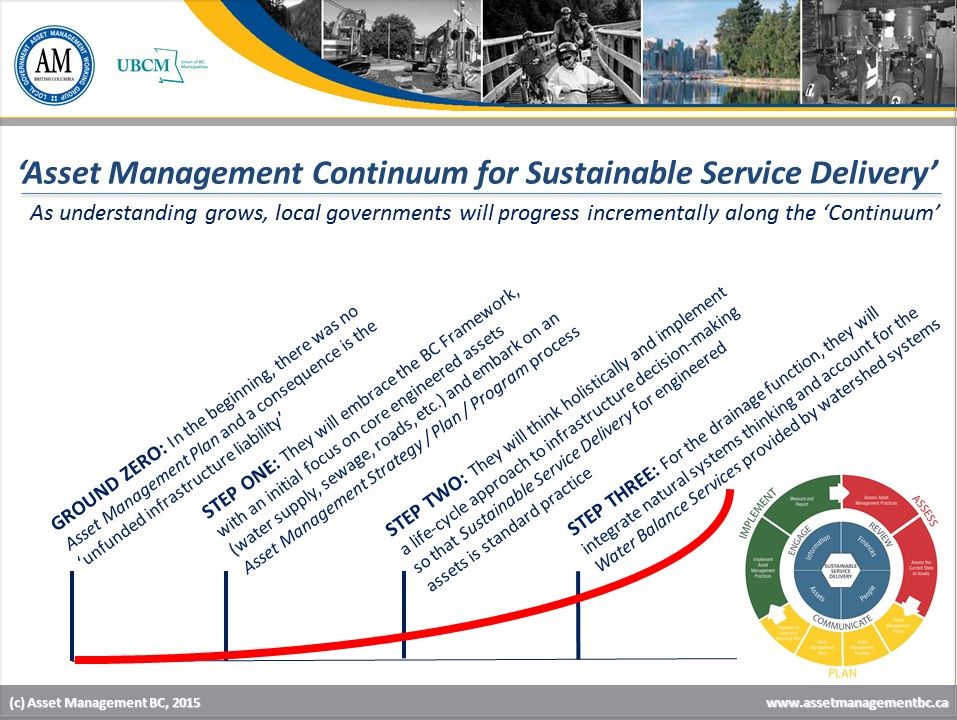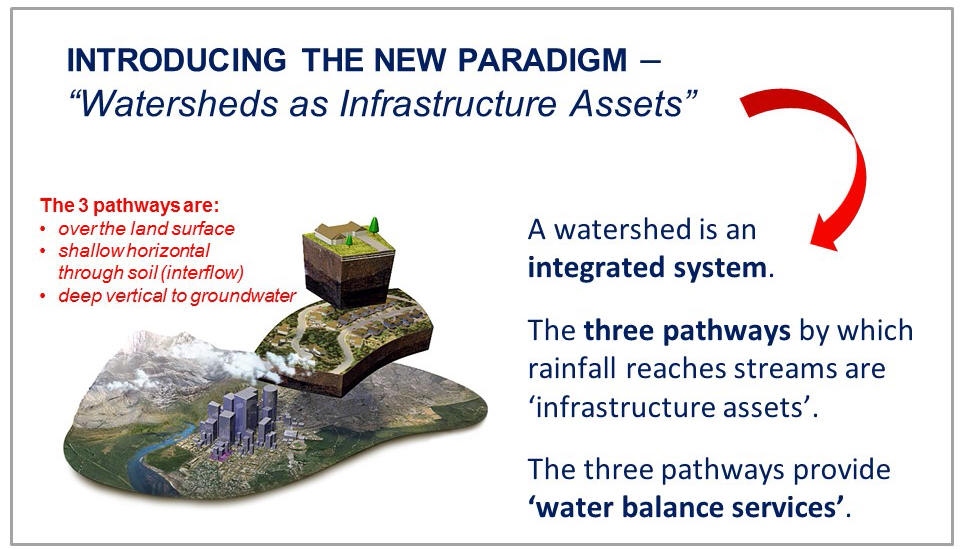Introducing the “Asset Management Continuum for Sustainable Service Delivery in British Columbia”
Note to Reader:
Released in December 2014, Asset Management for Sustainable Service Delivery: A BC Framework is a game-changer. It makes the link between local government services, the infrastructure that supports the delivery of those services, and the health of watershed systems. The Feast AND Famine Workshop, held in December, provided a forum for Glen Brown of UBCM to introduce the “asset management continuum” as a metaphor for describing incremental progression to Sustainability Service Delivery.
The graphic below was developed in collaboration with the Partnership for Water Sustainability and conceptualizes alignment of Partnership efforts with those of Asset Management BC to advance Sustainable Service Delivery.
Do you wonder how to incorporate “Watershed Systems Thinking” into Infrastructure Asset Management?
Years in the making, the vision for Sustainable Service Delivery became a reality with rollout of the outcome-oriented “BC Framework” in 2015. Because it is a driver for tackling the “unfunded infrastructure liability”, the BC Framework has garnered both national and international attention.
The BC Framework is a game-changer because it is strategically aligned with asset management requirements under senior government funding programs, in particular the Gas Tax Program. The BC Framework also points the way to integration of natural systems thinking and climate change thinking into asset management.
Click on Asset Management for Sustainable Service Delivery: A BC Framework (short version) to download a copy.
Asset Management & Ecosystem Services
“The ultimate vision for fully integrated Sustainability Service Delivery is that communities would protect, preserve, restore and manage natural assets in the same way that they manage their engineered assets,” states Glen Brown, General Manager (Victoria Operations), Union of BC Municipalities.
 “A watershed, and the ecosystem services that it provides, is a fundamental and integral part of a community’s infrastructure. This is not to suggest that all ecosystem services provide a municipal function. But trees, soil, green spaces and water do contribute a valuable municipal function in maintaining the hydrologic integrity of a healthy watershed system.”
“A watershed, and the ecosystem services that it provides, is a fundamental and integral part of a community’s infrastructure. This is not to suggest that all ecosystem services provide a municipal function. But trees, soil, green spaces and water do contribute a valuable municipal function in maintaining the hydrologic integrity of a healthy watershed system.”
The Asset Management Journey
“Implementation of asset management along with the associated evolution of local government thinking is a continuous process, not a discrete task. We needed a way to illustrate this diagrammatically, and thus communicate, what the journey by a local government to the eventual Sustainable Service Delivery destination would look like.”
“This led us to the concept of a continuum. The relevance of this way of thinking is that different local governments will always be at different points along the asset management continuum. This is why we focus on outcomes and do not prescribe what to do in BC.”
“The continuum (as shown on the image above) bridges two pieces. One piece is recognition that the asset management process is founded on an incremental approach. The other piece is integration of natural capital, natural assets and watershed systems thinking.”
Moving Towards “Sustainable Watershed Systems, through Asset Management”
“The BC Framework allows for tailoring of an approach to individual needs and capacities of individual local governments. Within BC, some local governments are well advanced. Some are just starting out. Over time, and through a continuous quality improvement process, the capacity and expertise for Sustainable Service Deliverywill inevitably increase within every local government.
“The branding logo for the BC Framework also represents a continuum. As local governments mature, both in terms of understanding and applying asset management principles, there is then the ability to appropriately incorporate and integrate natural capital into their asset and watershed plans. By also accounting for and integrating the services that nature provides, over time they can achieve the goal of sustainable service delivery for watershed systems,” concludes Glen Brown.
To Learn More:
Released in November 2015 by the Partnership for Water Sustainability, Beyond the Guidebook 2015: Moving Towards “Sustainable Watershed Systems, through Asset Management” is the third in a series that builds on Stormwater Planning: A  Guidebook for British Columbia.
Guidebook for British Columbia.
“Start with soil, vegetation and trees – protect and preserve the absorbency of the landscape in the Built Environment. Sustain the three pathways by which rainfall reaches streams,” states Peter Law, Partnership Director. Formerly with the Ministry of Environment, Peter Law was Chair of the Stormwater Guidebook Steering Committee.



